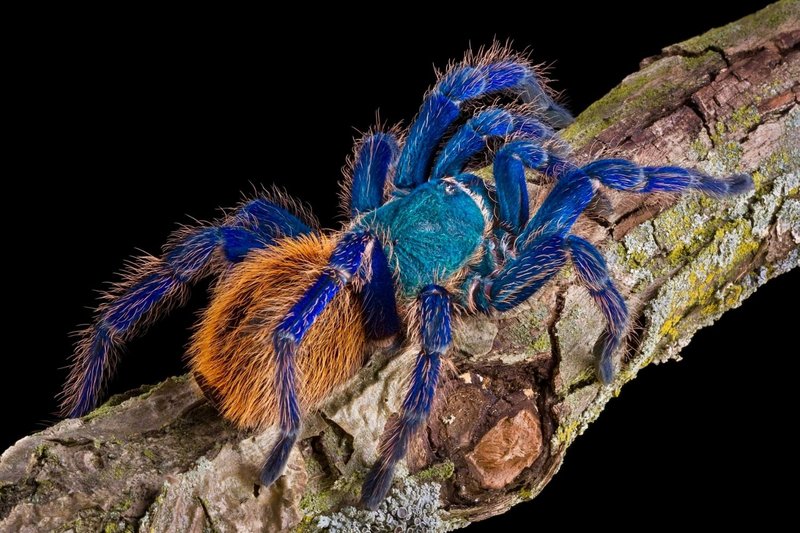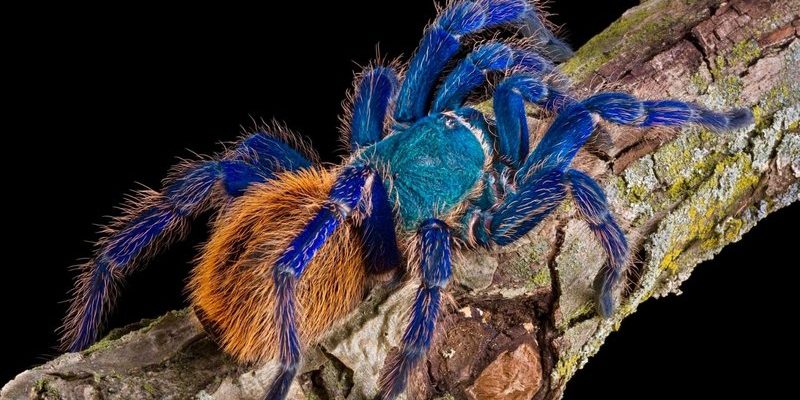
Imagine a creature that embodies the vibrant hues of a tropical rainforest: bright blue legs, a greenish carapace, and a wash of golden yellow on its underside. That’s the Greenbottle Blue Tarantula, known scientifically as Ceratogyrus meridionalis. Found primarily in the arid regions of West Africa, this tarantula has a personality as colorful as its appearance. If you’re curious to learn more about these intriguing spiders, you’ve come to the right place!
Physical Appearance
The Greenbottle Blue Tarantula has a striking appearance that makes it one of the most admired species among tarantula enthusiasts. You might think of it as the peacock of the tarantula world. Its vibrant blue legs catch the eye immediately, shimmering like sapphires under the right light. The carapace, or the shell on its back, has a greenish hue, giving it a unique, almost jewel-like quality.
Its underbelly is equally fascinating, featuring a golden yellow that contrasts beautifully with its blue legs. This visual appeal is one of the reasons why many people are drawn to this tarantula as a pet. However, it’s essential to remember that despite its beauty, the Greenbottle Blue has a defensive side too. Its bite may not be deadly, but it can be quite painful, similar to a hornet sting.
Habitat and Distribution
Let’s talk about where the Greenbottle Blue Tarantula makes its home. These spiders are native to the dry, arid regions of West Africa, especially countries like Namibia and South Africa. They thrive in environments that might seem harsh to us—a mix of rocky terrains and sparse vegetation—but that’s exactly where they flourish.
You might be wondering why they prefer these dry areas. Well, their natural habitat helps them avoid many predators, and they’ve adapted to the challenges of their environment in fascinating ways. They often dig burrows in the ground, providing a cozy retreat from the hot sun. Imagine it like having a little cave to curl up in on a blistering day!
Behavior and Temperament
If you ever get to observe a Greenbottle Blue Tarantula, you’ll find it has a rather unique personality. Generally, they are more aggressive compared to some other tarantula species. Think of them as the “bold” kids on the playground—they’re not afraid to show off their vibrant colors and exhibit some attitude!
They tend to be skittish, especially when they feel threatened. As a defense mechanism, they’ll often kick urticating hairs off their abdomens, which can irritate the skin of potential predators. However, given the right environment and care, these tarantulas can be surprisingly docile when kept as pets. Just remember to treat them with respect, and they might just become your new eight-legged friend.
Diet and Feeding Habits
The diet of the Greenbottle Blue Tarantula is as interesting as its appearance. Like most tarantulas, they’re carnivorous, primarily feasting on insects. A steady diet of crickets, mealworms, and roaches keeps them healthy and happy. For those who might consider keeping one as a pet, knowing about their diet is crucial.
Feeding them is generally straightforward. Just drop in a few live insects into their enclosure, and they’ll do the rest! Honestly, watching them hunt can be a mesmerizing experience—like a nature documentary unfolding right in your living room. However, be cautious not to overfeed them, as this can lead to health issues.
Life Cycle and Longevity
Understanding the life cycle of the Greenbottle Blue Tarantula gives us insight into their fascinating world. They undergo a process called molting, which is when they shed their old exoskeleton to allow for growth. This can happen several times throughout their life, especially in their early years. Each time they molt, it’s like they’re putting on a new outfit—only this outfit is a little bigger and shinier!
In the wild, these tarantulas can live quite a long life. Females, in particular, can live up to 25 years, making them a long-term commitment for any pet owner. Males, however, have a shorter lifespan, usually around 5–10 years. If you ever find yourself with a Greenbottle Blue, you’ll need to be ready for many years of companionship—just like getting a puppy, but with a few more legs!
Keeping a Greenbottle Blue Tarantula as a Pet
Thinking about bringing a Greenbottle Blue Tarantula into your home? It’s essential to create a comfortable environment for them. They thrive in a terrarium with plenty of vertical space for climbing and web-building. Adding substrate like peat or coconut coir allows them to burrow and feel safe.
Temperature and humidity are crucial too. A warm environment around 75-80°F with adequate humidity is best. Just picture it like creating a mini oasis in your living room! You might need to mist the enclosure occasionally to maintain the right moisture levels. And don’t forget, handling should be minimal. While they can be beautiful pets, they’re not toys!
The Greenbottle Blue Tarantula is truly a remarkable creature that captivates anyone willing to take the time to learn about it. With its stunning appearance, intriguing behaviors, and unique habitat, it’s no wonder they’re becoming increasingly popular among pet enthusiasts. Just remember, while they may look beautiful, they also have their quirks and require a bit of extra care.
So, whether you’re a beginner fascinated by the wonders of the spider world or just looking for something different in the realm of pets, the Greenbottle Blue is definitely worth considering. Just ensure you’re ready for the responsibility—after all, any pet is a commitment, and this vibrant tarantula is no different!

